update 22.
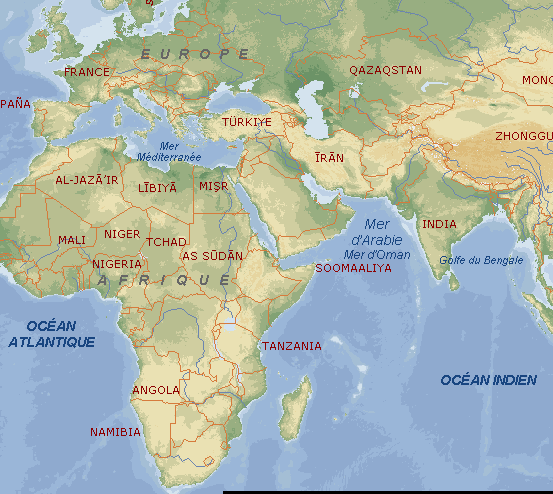 of gurus and ghats
of gurus and ghats
13 April 2008
Total kilometers cycled: 35,135
India: Tamil Nadu and Kerala
Specific country info on routes & roads/food & accommodation/the locals available here.
“Twenty years from now you will be more
disappointed by the things you didn’t do than by the ones you
did do. So throw
off the bowlines, sail away from the safe harbor. Catch the trade winds
in your
sails. Explore. Dream. Discover.” - Mark
Twain
Non-stop India, is this really the place to go to relax and recover from Africa exhaustion? A resounding no, was my initial conclusion as I pedaled out of the safe confines of the Chennai International Airport with it's slick coffee shops and orderly efficiency, into morning rush hour in a city of more than 6 million. A rickety Tata bus bursting with passengers was barreling down the congested thoroughfare, seemingly intent on running me off the road. The driver laid on the shrill horn, which is the Indian way of saying your time has come if you don't get out of my way in the next 10 seconds. I hurtled to the side of
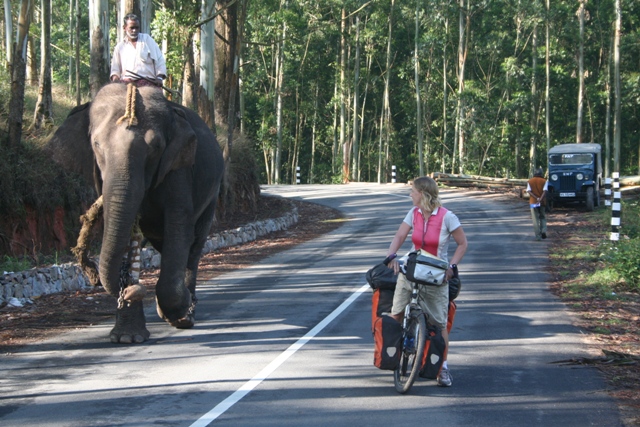 the road, narrowly missing a scrape with
a lumbering cow, took a deep inhalation of fresh morning air only
slightly tainted
with noxious fumes and scanned the surroundings for Eric. Unfazed
by the circus of itinerant salesmen struggling under the weight of
their
wares, various livestock picking through the piles of
rubbish, rickshaws careening through the
crowds, not to mention the numerous Tata death-machines
plying the road, he was cycling serenely as if on a
quiet country lane rather than in the midst of a major Indian metropolis.
I admired his sang-froid.
the road, narrowly missing a scrape with
a lumbering cow, took a deep inhalation of fresh morning air only
slightly tainted
with noxious fumes and scanned the surroundings for Eric. Unfazed
by the circus of itinerant salesmen struggling under the weight of
their
wares, various livestock picking through the piles of
rubbish, rickshaws careening through the
crowds, not to mention the numerous Tata death-machines
plying the road, he was cycling serenely as if on a
quiet country lane rather than in the midst of a major Indian metropolis.
I admired his sang-froid.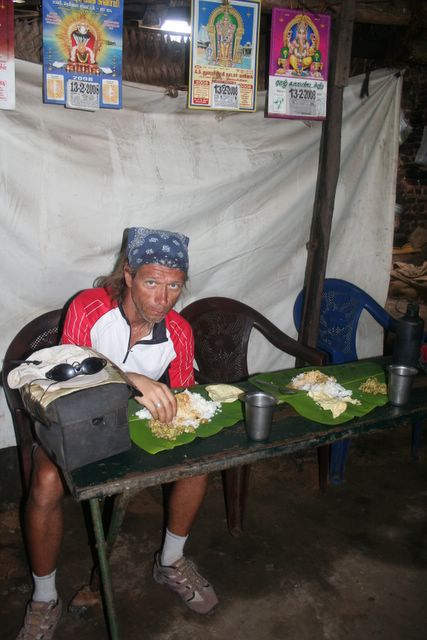 Ah,
the sights, sounds and smells of India...elegantly dressed women in
colorful silk saris stepping down from old-fashioned Ambassador taxis,
dad driving three fresh faced kids to school on his battered
motorcycle,two on the back and the smallest teetering in front, beggars
pleading for alms, temple music being blared out at decibels
reminiscent of an 80's rock concert, the aromas of sweet curry, spicy chai
and sandalwood incense mixed with those of cow dung, decaying
vegetables and urine. India takes some
getting used to.
Ah,
the sights, sounds and smells of India...elegantly dressed women in
colorful silk saris stepping down from old-fashioned Ambassador taxis,
dad driving three fresh faced kids to school on his battered
motorcycle,two on the back and the smallest teetering in front, beggars
pleading for alms, temple music being blared out at decibels
reminiscent of an 80's rock concert, the aromas of sweet curry, spicy chai
and sandalwood incense mixed with those of cow dung, decaying
vegetables and urine. India takes some
getting used to. Thanks to the kind-hearted Chennai police, who on several occasions brought traffic to a complete halt so we could traverse the chaotic intersections without being flattened by an overloaded lorry, we made it out of Chennai with bikes and bodies intact. Then it was on to the almost idyllic East Coast Highway with palm-fringed beaches on our left, a gentle breeze blowing from behind and plenty of tea stalls scattered along the way serving up a mean masala chai and tasty thalis, idlis and dosas on banana leaves. It was lovely riding, although we were somewhat concerned about the 'beware of thieves' signs posted at even intervals along the road.
Our first stop was the seaside town of Mammallapurum, fabled for it's enchanting shore temples and a popular stop on the
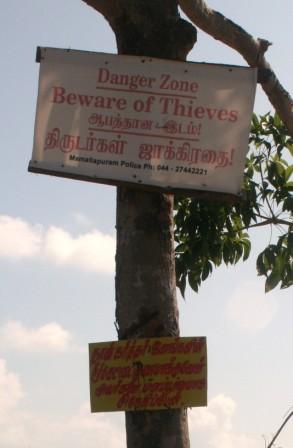 backpacker
route. It was our good intention to soak up a bit of culture, but
in reality observing and getting to know our fellow
western tourists proved far more interesting. As one would
expect in India, there were the usual aging hippies, skin deeply
bronzed and leather-like from so much time spent lazing about on the
beaches of Goa, graying and balding men still sporting pony-tails
and were wearing the tie-dyed trousers. Then there are the
photo enthusiasts who stroll around with cameras that probably cost
more than the average Indian
is likely to earn in his entire lifetime. These types are
generally popular with the locals because they hand out sweets to the
kids, coins to the beggars and a fair amount of cash to the Kashmiri
shop owners who hawk everything from hand-made carpets and carvings to
mirrored Rajasthani crafts. Many Americans, often inspired
by Elizabeth Gilbert's Eat, Pray, Love
backpacker
route. It was our good intention to soak up a bit of culture, but
in reality observing and getting to know our fellow
western tourists proved far more interesting. As one would
expect in India, there were the usual aging hippies, skin deeply
bronzed and leather-like from so much time spent lazing about on the
beaches of Goa, graying and balding men still sporting pony-tails
and were wearing the tie-dyed trousers. Then there are the
photo enthusiasts who stroll around with cameras that probably cost
more than the average Indian
is likely to earn in his entire lifetime. These types are
generally popular with the locals because they hand out sweets to the
kids, coins to the beggars and a fair amount of cash to the Kashmiri
shop owners who hawk everything from hand-made carpets and carvings to
mirrored Rajasthani crafts. Many Americans, often inspired
by Elizabeth Gilbert's Eat, Pray, Love 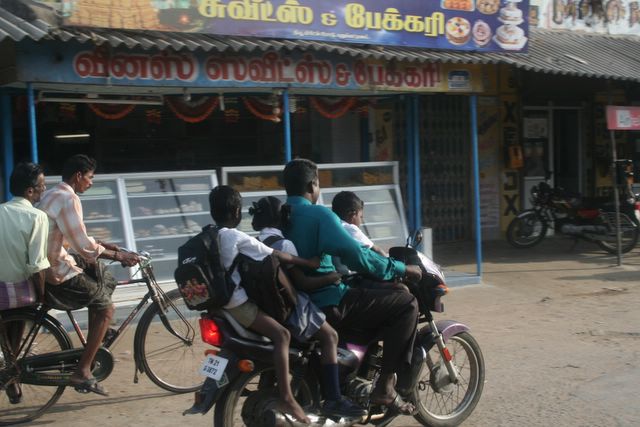 who left well-paying corporate jobs to 'find
themselves' in India and escape from what some call the 'bubble
existence' they led in the States.
Young graduates
taking a year out have gone decidedly upscale (one asks where the money
comes from), toting backpacks that convert into respectable
suitcases with handles and wheels, travelling by taxi rather than rickshaw, checking into
lodges with satellite TV and hot showers and disdaining the grungy
guest houses and cold bucket showers
who left well-paying corporate jobs to 'find
themselves' in India and escape from what some call the 'bubble
existence' they led in the States.
Young graduates
taking a year out have gone decidedly upscale (one asks where the money
comes from), toting backpacks that convert into respectable
suitcases with handles and wheels, travelling by taxi rather than rickshaw, checking into
lodges with satellite TV and hot showers and disdaining the grungy
guest houses and cold bucket showers 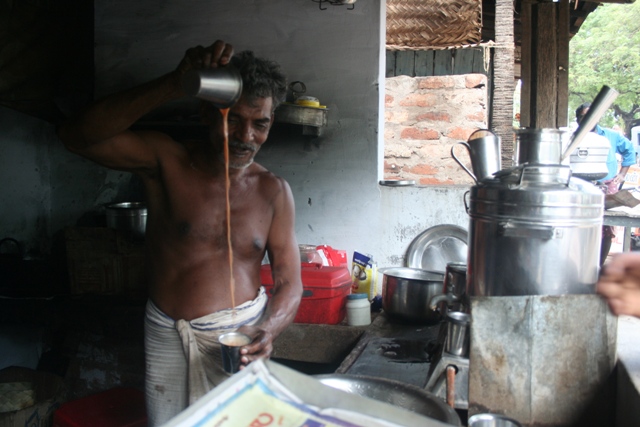 once popular with young travelers
of a bygone age. Even the ubiquitous package tourist, once
limited to places like Acapulco, Mallorca or Corfou now makes a showing
in India. Arriving in luxury coaches they can be seen clutching their
bags as they are herded between palaces, viewpoints and temples
before being carted off to their 'European standard hotel' where they
will enjoy continental cuisine and be treated to an evening cultural
program. Squat toilets, street food, and conversations with the
locals will not be part of the program. And then there are a few
sorry souls like ourselves who choose to cycle around a
country that has one of the highest highway fatality rates in the world.
once popular with young travelers
of a bygone age. Even the ubiquitous package tourist, once
limited to places like Acapulco, Mallorca or Corfou now makes a showing
in India. Arriving in luxury coaches they can be seen clutching their
bags as they are herded between palaces, viewpoints and temples
before being carted off to their 'European standard hotel' where they
will enjoy continental cuisine and be treated to an evening cultural
program. Squat toilets, street food, and conversations with the
locals will not be part of the program. And then there are a few
sorry souls like ourselves who choose to cycle around a
country that has one of the highest highway fatality rates in the world.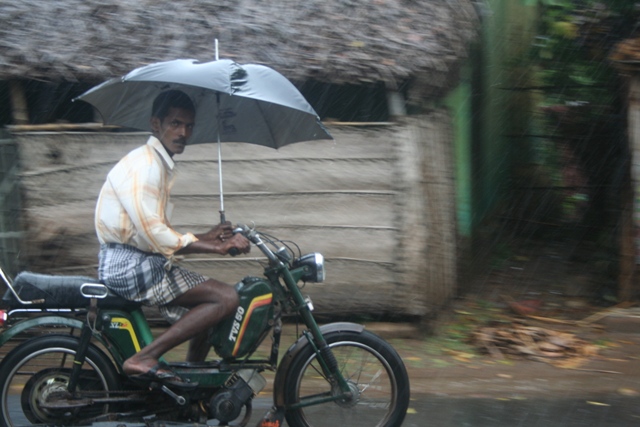 We
put off the plunge into 'real India' by first spending two weeks
in the International Township of Auroville. Since its founding in
1968 by a handful of intrepid settlers in a barren corner of Tamil Nadu
, Auroville has grown into a bustling community of over 2,000 people
representing some 40 nations. It's an experiment in human unity
whose aim is to create a self-sufficient city of 50,000 where each
individual's needs are met by the community and work is a means of
expression rather than for gaining one's livelihood. There's
obviously still lots of work to be done, but what has been achieved
over the past 40 years is impressive. The numerous schools are
equipped with all the latest technology, more than a dozen organic
farms provide fruit, vegetables and diary products to the community,
there are many innovative architectural projects, a health center
and dental clinic provide free services to residents, regular classes
in yoga, martial arts, languages, aerobics and dance take place,
there's even a cinema showing films from around the world plus they've
got their own radio station. What was once almost desert is now
covered in trees and shady cycle paths criss-cross the settlement.
There's definitely a certain spiritual energy that can be felt,
but, like any close-knit community there are lots of politics and
in-fighting to deal with .
It's a place that takes time to discover and we're planning on
returning there for a longer stay towards the end of our India trip.
We
put off the plunge into 'real India' by first spending two weeks
in the International Township of Auroville. Since its founding in
1968 by a handful of intrepid settlers in a barren corner of Tamil Nadu
, Auroville has grown into a bustling community of over 2,000 people
representing some 40 nations. It's an experiment in human unity
whose aim is to create a self-sufficient city of 50,000 where each
individual's needs are met by the community and work is a means of
expression rather than for gaining one's livelihood. There's
obviously still lots of work to be done, but what has been achieved
over the past 40 years is impressive. The numerous schools are
equipped with all the latest technology, more than a dozen organic
farms provide fruit, vegetables and diary products to the community,
there are many innovative architectural projects, a health center
and dental clinic provide free services to residents, regular classes
in yoga, martial arts, languages, aerobics and dance take place,
there's even a cinema showing films from around the world plus they've
got their own radio station. What was once almost desert is now
covered in trees and shady cycle paths criss-cross the settlement.
There's definitely a certain spiritual energy that can be felt,
but, like any close-knit community there are lots of politics and
in-fighting to deal with .
It's a place that takes time to discover and we're planning on
returning there for a longer stay towards the end of our India trip.As we left the serenity of Auroville to face the chaos of India, heading further south down the East Coast Highway, a tropical downpour caught us bt surprise and brought our bicycles to a halt. While we took cover in a tea shop, the clever Indians continued to speed by on motorbikes and bicycles, expertly steering with one hand and gripping an umbrella in the other. We were on our way to Kanyakumari, the so-called 'Land's End' of the Indian sub-continent where the Bay of Bengal meets the Indian Ocean and the Arabian Sea, to join the thousands of Hindus who come to this holy place to bathe in the sacred waters and be blessed in the village temple. Like hundreds of other pilgrims staying at the Vivekananda ashram,
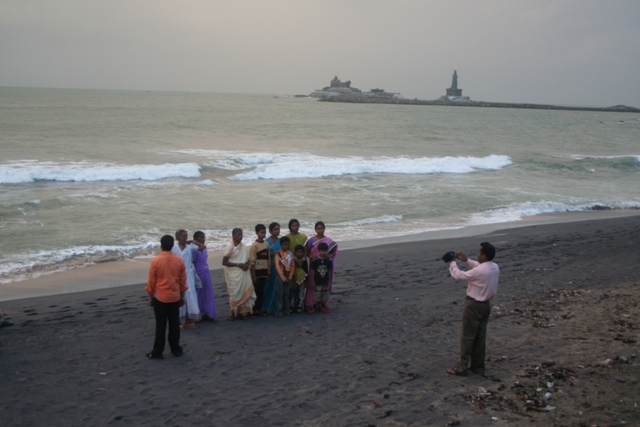 we
woke before daybreak to shuffle down to the beach, take photos and
watch the sunrise over the sea. Indian pilgrims, unlike the dour image
we have of their 17th century American counterparts, are a lively lot
who mix a lot of holiday with what is meant to be holy. Men kit
themselves out with special 'pilgrim dhotis' (ankle-length sarong),
womens splurge on all sorts of made in China trinkets sold in the shops
lining the streets nearby the temple, children are treated to ice cream
and sweets, even vehicles are dressed up with a garland of
marigolds, flags and a kitschy temple replica.
we
woke before daybreak to shuffle down to the beach, take photos and
watch the sunrise over the sea. Indian pilgrims, unlike the dour image
we have of their 17th century American counterparts, are a lively lot
who mix a lot of holiday with what is meant to be holy. Men kit
themselves out with special 'pilgrim dhotis' (ankle-length sarong),
womens splurge on all sorts of made in China trinkets sold in the shops
lining the streets nearby the temple, children are treated to ice cream
and sweets, even vehicles are dressed up with a garland of
marigolds, flags and a kitschy temple replica. 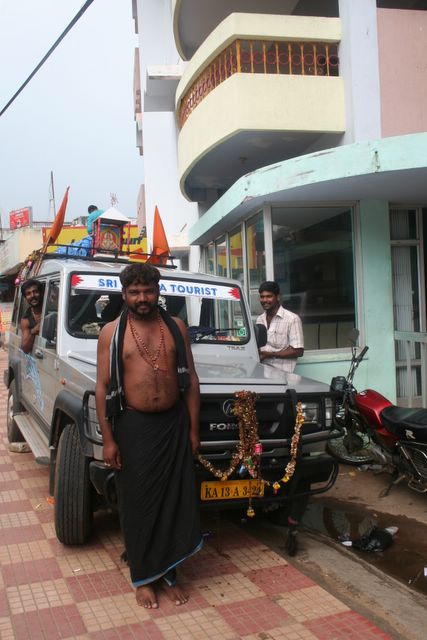 'The
two-week Yoga Vacation will leave you feeling peaceful and relaxed,
inspired and recharged', claimed the brochure from the Sivananda Ashram
at Neyar Dam. With that in mind, we headed north into the
foothills of the Western Ghats to voluntarily submit ourselves to Yogi
Bootcamp, where each day we would be woken to the clang of a bell at
5:20 AM, remain seated in a cross-legged position on the hard granite
floor for 4 hours while meditating, chanting or listening to the Swami
expound on yogic philosophy, complete an hour of self-less service (ie
unpaid labor), and spend 5 hours stretching and contorting our bodies
into all sorts of unnatural positions. The fun-filled package,
including two healthy vegetarian meals (taken while seated in a
comfortable,cross-legged position of course) and simple accommodation,
for the bargain price of $15 a day, payable in advance by credit card.
With a mixture of eager anticipation and fear (was this some sort
of cult?), we passed through the entry way inscribed with the motto 'Serve, Love, Give, Purify, Meditate, Realise' an
joined more than a hundred other seekers of peace and happiness.
'The
two-week Yoga Vacation will leave you feeling peaceful and relaxed,
inspired and recharged', claimed the brochure from the Sivananda Ashram
at Neyar Dam. With that in mind, we headed north into the
foothills of the Western Ghats to voluntarily submit ourselves to Yogi
Bootcamp, where each day we would be woken to the clang of a bell at
5:20 AM, remain seated in a cross-legged position on the hard granite
floor for 4 hours while meditating, chanting or listening to the Swami
expound on yogic philosophy, complete an hour of self-less service (ie
unpaid labor), and spend 5 hours stretching and contorting our bodies
into all sorts of unnatural positions. The fun-filled package,
including two healthy vegetarian meals (taken while seated in a
comfortable,cross-legged position of course) and simple accommodation,
for the bargain price of $15 a day, payable in advance by credit card.
With a mixture of eager anticipation and fear (was this some sort
of cult?), we passed through the entry way inscribed with the motto 'Serve, Love, Give, Purify, Meditate, Realise' an
joined more than a hundred other seekers of peace and happiness. 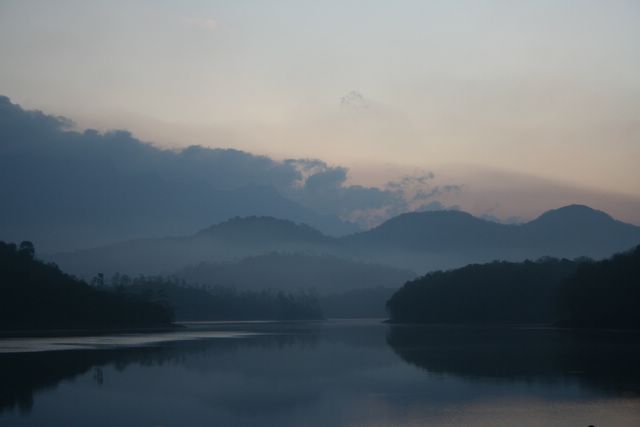 Just before 6PM a line began to form outside the dining hall and
then a gentle faced Indian man with impeccable posture began leading
the group in a round of Hare Krishna chanting. When everyone was
seated on the slate floor, a Sanskrit prayer, unintelligible to we
newcomers, was recited in unison. We then began eating in an enforced
silence, careful to use the right hand as the left is traditionally
reserved for toilet functions. As is the custom in India, no
utensils were used. In a concession to Western ways (or
perhaps it was sheer commercialism) a small cafe called the Health Hut
was established on the Ashram premises. For a few hours a
day, yoga devotees were allowed to escape from the monastic
lifestyle for a chat and a banana milkshake or fruit salad while seated
comfortably, not in the cross-legged position, but at bamboo picnic
tables. Even forks and spoons were provided. Naturally,
these indulgences cost extra. The atmosphere at the Health Hut
was not much different than in any other restaurant catering to
tourists. Mostly it revolved around travel and where you had been
and where you were headed to next. Although there were a good
number of Indian Nationals studying at the Ashram, most of the cafe
clients were foreigners: Koreans, Japanese, Chinese, Russians,
Israelis, Iranians, Poles, French, British, Americans, Canadians,
Italians, Spaniards, Portuguese, Tibetans, Australians, Scandinavians,
Germans, Dutch, Mexicans, Brazilians even the African continent was
represented by a women from Benin and a young guy from Kenya.
Closing time at the Health Hut was 7:30 PM, as we were all
expected to be at Shiva Hall by 8:00 for the evening meditation and
chanting gala. Just like in school, attendance was mandatory.
We were all assigned numbers and required to check in with one of
the monitors stationed at the entrance before each activity. It
was all for our own good, we were told, the immersion in spirituality
needed to be total and slacking off wouldn't be permitted.
Just before 6PM a line began to form outside the dining hall and
then a gentle faced Indian man with impeccable posture began leading
the group in a round of Hare Krishna chanting. When everyone was
seated on the slate floor, a Sanskrit prayer, unintelligible to we
newcomers, was recited in unison. We then began eating in an enforced
silence, careful to use the right hand as the left is traditionally
reserved for toilet functions. As is the custom in India, no
utensils were used. In a concession to Western ways (or
perhaps it was sheer commercialism) a small cafe called the Health Hut
was established on the Ashram premises. For a few hours a
day, yoga devotees were allowed to escape from the monastic
lifestyle for a chat and a banana milkshake or fruit salad while seated
comfortably, not in the cross-legged position, but at bamboo picnic
tables. Even forks and spoons were provided. Naturally,
these indulgences cost extra. The atmosphere at the Health Hut
was not much different than in any other restaurant catering to
tourists. Mostly it revolved around travel and where you had been
and where you were headed to next. Although there were a good
number of Indian Nationals studying at the Ashram, most of the cafe
clients were foreigners: Koreans, Japanese, Chinese, Russians,
Israelis, Iranians, Poles, French, British, Americans, Canadians,
Italians, Spaniards, Portuguese, Tibetans, Australians, Scandinavians,
Germans, Dutch, Mexicans, Brazilians even the African continent was
represented by a women from Benin and a young guy from Kenya.
Closing time at the Health Hut was 7:30 PM, as we were all
expected to be at Shiva Hall by 8:00 for the evening meditation and
chanting gala. Just like in school, attendance was mandatory.
We were all assigned numbers and required to check in with one of
the monitors stationed at the entrance before each activity. It
was all for our own good, we were told, the immersion in spirituality
needed to be total and slacking off wouldn't be permitted.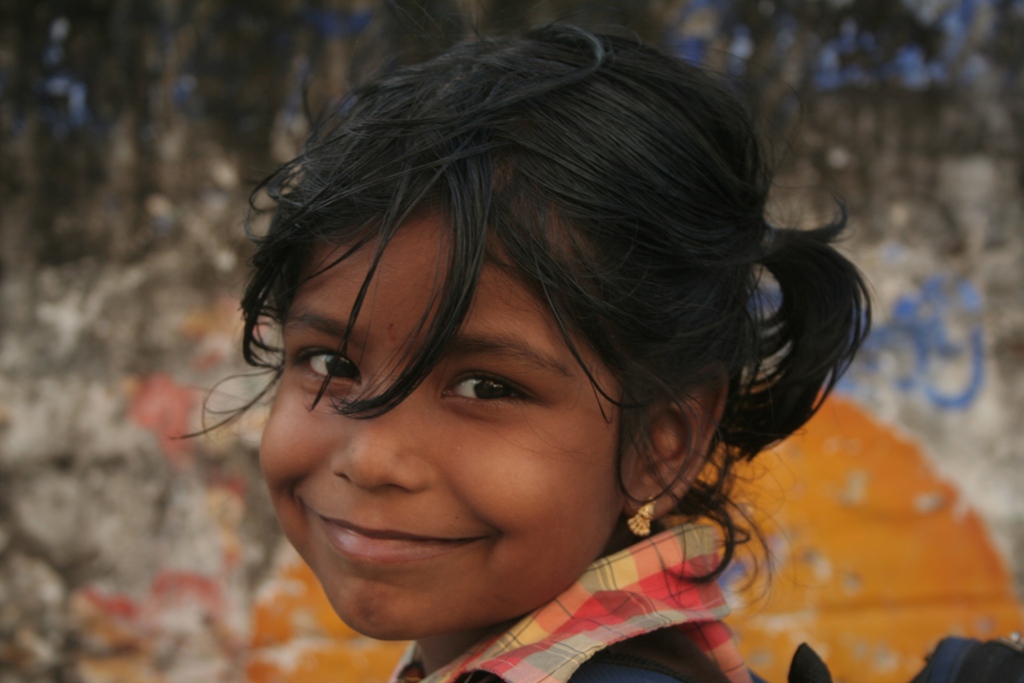 The seance, presided over by a big-bellied Italian Swami (was he really
following the basic tenets of proper exercise and diet?), began with
the chanting of the sacred AUM, the universal call for peace.
Then we were instructed to close our eyes, sit straight,
concentrate on our breath and inwardly repeat our personal mantra, if we
had yet to acquire a personal mantra we continue with Aum. After
what seemed to me an interminable length of time, I checked my watch (7
minutes had passed) and furtively glanced around to see what the others
were doing. A few of the other newcomers were squirming around
and stretching their legs, but to my horror I saw that most people
(including my husband) were maintaining their perfect posture and
appeared to be in a state of deep mediation. I obviously had
considerable progress to make and concluded that my chances of
obtaining enlightenment in this lifetime were slim. The best I
could probably hope for was to reincarnate as a human being and not
regress into the animal realm. The lively chanting and yoga
exercises, I was to find, suited my active nature much better.
The seance, presided over by a big-bellied Italian Swami (was he really
following the basic tenets of proper exercise and diet?), began with
the chanting of the sacred AUM, the universal call for peace.
Then we were instructed to close our eyes, sit straight,
concentrate on our breath and inwardly repeat our personal mantra, if we
had yet to acquire a personal mantra we continue with Aum. After
what seemed to me an interminable length of time, I checked my watch (7
minutes had passed) and furtively glanced around to see what the others
were doing. A few of the other newcomers were squirming around
and stretching their legs, but to my horror I saw that most people
(including my husband) were maintaining their perfect posture and
appeared to be in a state of deep mediation. I obviously had
considerable progress to make and concluded that my chances of
obtaining enlightenment in this lifetime were slim. The best I
could probably hope for was to reincarnate as a human being and not
regress into the animal realm. The lively chanting and yoga
exercises, I was to find, suited my active nature much better.
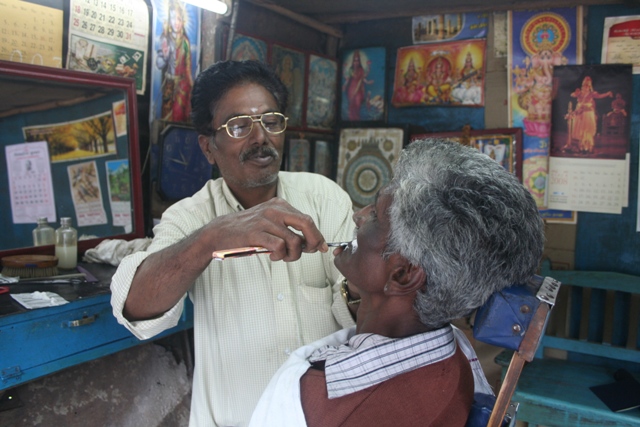 The two weeks passed in a flash, and although we were tired of being
preached to by the hypocritical Santa Claus Swami, and found Westerners
going by the names of Vishnu or Lakshmi a bit odd, the yoga classes
were so beneficial we extended our stay for another week.
Eventually we said our final farewells at the Ashram,
embraced our new found freedoms and spent the following week just 60
kilometers away at Kovalam beach recovering from the rigors of our Yoga
Vacation. We settled into a room in a comfortable family house
not far from the beach and were enjoying a quiet afternoon on the
veranda when the boom of fire crackers accompanied by eerie,
ear-splitting music shook us out of our peace. When I
questioned the man of the house about all the racket he just gave me
one of those typically Indian sideways nods, pointed round the corner
and repeated several times, 'Kali temple,madam, they make puja'
How could we possibly have taken a room almost smack-dab next to
a temple dedicated to the goddess of destruction?
The two weeks passed in a flash, and although we were tired of being
preached to by the hypocritical Santa Claus Swami, and found Westerners
going by the names of Vishnu or Lakshmi a bit odd, the yoga classes
were so beneficial we extended our stay for another week.
Eventually we said our final farewells at the Ashram,
embraced our new found freedoms and spent the following week just 60
kilometers away at Kovalam beach recovering from the rigors of our Yoga
Vacation. We settled into a room in a comfortable family house
not far from the beach and were enjoying a quiet afternoon on the
veranda when the boom of fire crackers accompanied by eerie,
ear-splitting music shook us out of our peace. When I
questioned the man of the house about all the racket he just gave me
one of those typically Indian sideways nods, pointed round the corner
and repeated several times, 'Kali temple,madam, they make puja'
How could we possibly have taken a room almost smack-dab next to
a temple dedicated to the goddess of destruction? 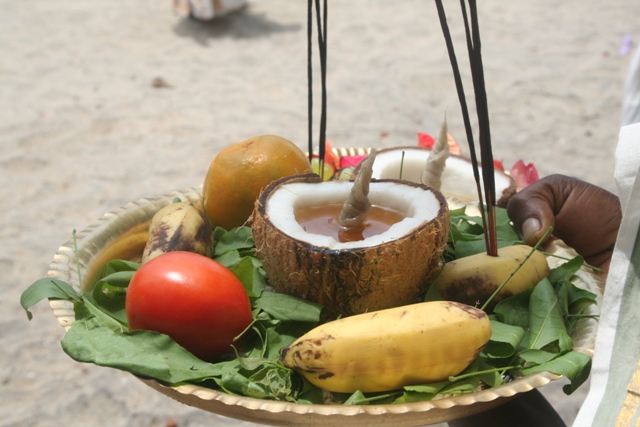
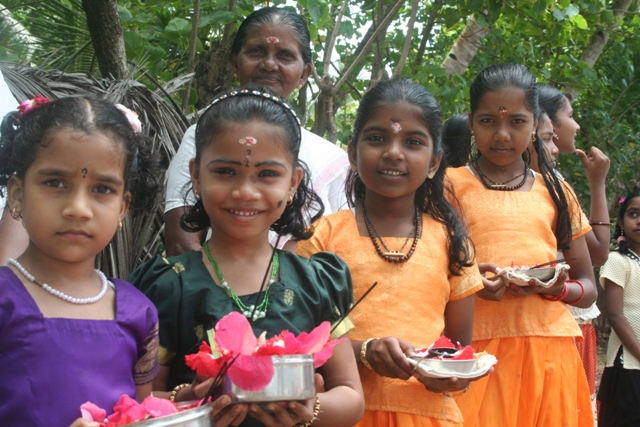
All of India seems to be imbibed in spirituality or religion of some sort. Our next ashram stop, was that of Amma, better known as the Hugging Mother in the West. She is one of India's few female gurus and is best known for the thousands of embraces she gives during darshan sessions that can last for hours. Her popularity has spread worldwide and she now spends just a few months a year in India spending the rest of the year abroad spreading her message of love and compassion. Amma was out when we arrived so the ashram was relatively quiet. After visiting the foreign guest services office and turning over our passports, we were ushered up to the 11th floor of a tower block over looking the main temple and beyond, an amazing view over the Arabian Sea. Many gurus end up in a cloud of controversy, but Amma appears to be above reproach. Her foundation has built hospitals, schools, a university, housing for the poor, homes for the aged and she has even been recognized by the United Nations for her humanitarian efforts. Life at Amma's is far less strict than at the Sivananda Ashram and you can basically do what you want, apart from smoking cigarettes, taking drugs or eating meat. Chanting was optional which suited Eric just fine.
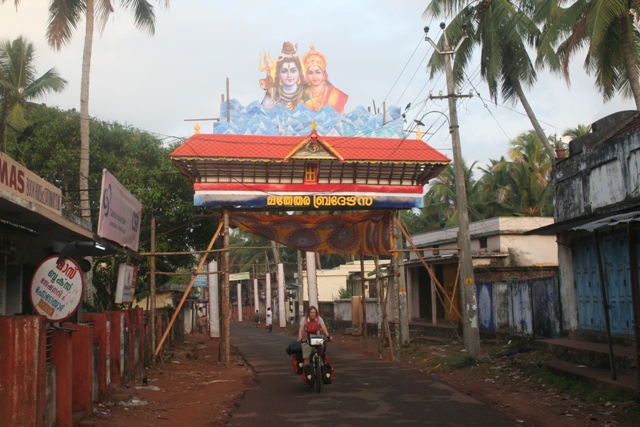 After leaving Amma's we cycled on through the peaceful Kerala
countryside in the area known as the backwaters because the narrow
strips of land are surrounded by networks of waterways that fringe the
coast and then wind their way inland. We meant to spend just one night
in a place called Kumily before heading up to the high tea estates of
Munnar, but ended up staying six due to the almost non-stop rain.
With satellite TV, hot showers and home-made chocolate available
at the corner shop the delay was almost bearable and thanks to the BBC
we were able to catch up on all the world crises. Easter Sunday
the sun finally peaked out from behind the clouds and we loaded up the
panniers and headed on our way, to Munnar that is. The scenery
was worth the wait. The road snaked its way through the manicured
tea estates, climbing higher and higher until the craggy peaks of the
Western Ghats came into view. We spent four days exploring the
surrounding hills and enjoying the crisp mountain air and sunny spring
weather before deciding it was time to move on to Kodaikanal, one of South India's most famous hill stations.
After leaving Amma's we cycled on through the peaceful Kerala
countryside in the area known as the backwaters because the narrow
strips of land are surrounded by networks of waterways that fringe the
coast and then wind their way inland. We meant to spend just one night
in a place called Kumily before heading up to the high tea estates of
Munnar, but ended up staying six due to the almost non-stop rain.
With satellite TV, hot showers and home-made chocolate available
at the corner shop the delay was almost bearable and thanks to the BBC
we were able to catch up on all the world crises. Easter Sunday
the sun finally peaked out from behind the clouds and we loaded up the
panniers and headed on our way, to Munnar that is. The scenery
was worth the wait. The road snaked its way through the manicured
tea estates, climbing higher and higher until the craggy peaks of the
Western Ghats came into view. We spent four days exploring the
surrounding hills and enjoying the crisp mountain air and sunny spring
weather before deciding it was time to move on to Kodaikanal, one of South India's most famous hill stations.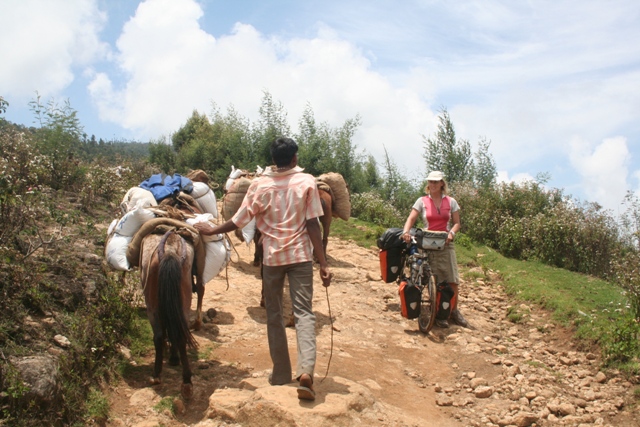 Being suckers for shortcuts, we readily agreed to take the road going
over Top Station which would involve a 15 kilometer stretch of rough
forest road but would cut almost 100 kilometers off the journey to
Kodai. Should be a piece of cake for two seasoned cyclists, or so
we foolishly thought. We should have listened to the
villagers at the turnoff to the 'forest road' who continued to
repeat 'danger, cycle no go'. But villagers have been warning
us about bad roads ahead for almost two years, so why should we start
heeding their advice now? The difference, I suppose, is that in
Africa there's usually only one road so you don't have a choice, you
either stay put and live out the rest of your days in some God-forsaken
corner of the Congo or forge ahead. The 'forest road' we turned
on to was really a mule track and a rough one at that. After 500
meters of pushing and pedaling the road was blocked by two enterprising
young men with chainsaws who were felling trees at a fast rate. I
doubt they had the authorization to do so, but then again I don't think
they reckoned with seeing any traffic on 'the road'. Images of The Texas Chainsaw Massacre
briefly flashed through my mind, but the hard working boys were
friendly enough and helped us lug the bikes over all those trees.
They assured us there were no more clandestine lumberjacks ahead.
Being suckers for shortcuts, we readily agreed to take the road going
over Top Station which would involve a 15 kilometer stretch of rough
forest road but would cut almost 100 kilometers off the journey to
Kodai. Should be a piece of cake for two seasoned cyclists, or so
we foolishly thought. We should have listened to the
villagers at the turnoff to the 'forest road' who continued to
repeat 'danger, cycle no go'. But villagers have been warning
us about bad roads ahead for almost two years, so why should we start
heeding their advice now? The difference, I suppose, is that in
Africa there's usually only one road so you don't have a choice, you
either stay put and live out the rest of your days in some God-forsaken
corner of the Congo or forge ahead. The 'forest road' we turned
on to was really a mule track and a rough one at that. After 500
meters of pushing and pedaling the road was blocked by two enterprising
young men with chainsaws who were felling trees at a fast rate. I
doubt they had the authorization to do so, but then again I don't think
they reckoned with seeing any traffic on 'the road'. Images of The Texas Chainsaw Massacre
briefly flashed through my mind, but the hard working boys were
friendly enough and helped us lug the bikes over all those trees.
They assured us there were no more clandestine lumberjacks ahead. 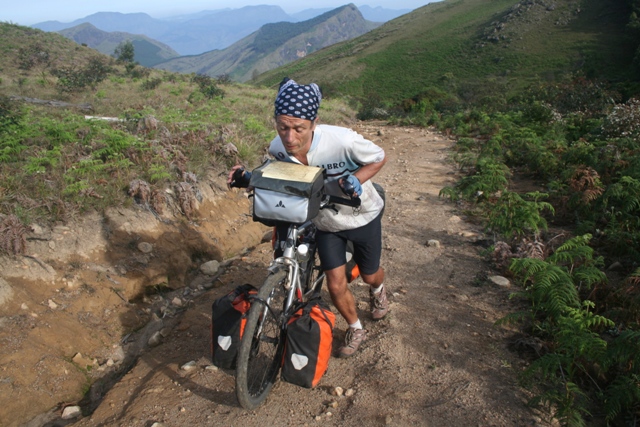 To
make a long story short, the track branched off in two directions and
we chose the way that went up over a steep ridge, down a valley and
eventually petered out into a footpath overgrown by ferns. By
this time it was getting late, so we scouted out a relatively flat
and rock-free spot big enough to pitch the tent, built a fire and
broke into our stash of instant mash potatoes we'd been hoarding
since Cape Town. Amazing how delicious those industrial spuds
tasted. After backtracking and cursing for several hours the next day,
pushing much of the way, we eventually found the right path and made it
up and over the mountainside and down into the valley where a village
lay. Three days, a hundred kilometers, next time we'll stick to the
main road.
To
make a long story short, the track branched off in two directions and
we chose the way that went up over a steep ridge, down a valley and
eventually petered out into a footpath overgrown by ferns. By
this time it was getting late, so we scouted out a relatively flat
and rock-free spot big enough to pitch the tent, built a fire and
broke into our stash of instant mash potatoes we'd been hoarding
since Cape Town. Amazing how delicious those industrial spuds
tasted. After backtracking and cursing for several hours the next day,
pushing much of the way, we eventually found the right path and made it
up and over the mountainside and down into the valley where a village
lay. Three days, a hundred kilometers, next time we'll stick to the
main road.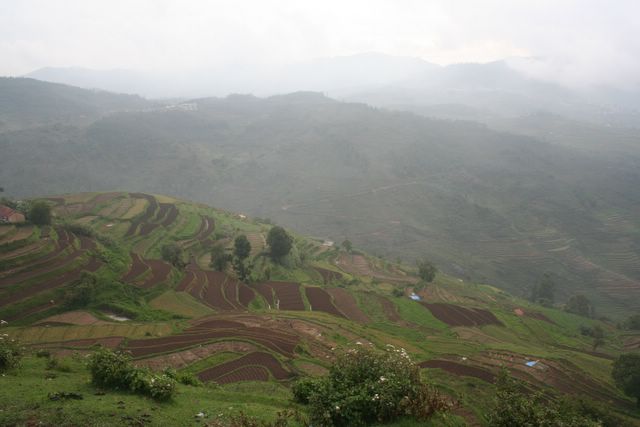 The fragrant tea
plantations gave way to tidy terraced farms growing onions, carrots,
potatoes and all sorts of other vegetables that thrive in the cool
climate of the Western Ghats. Kodai itself was a veritable
madhouse of tourist activity, something like the South of France in
August or Disneyland on a hot summer's day. A steady stream of
buses transporting Indian tourists delirious with holiday joy
continued to pass us as we climbed up to 2,100 meters before reaching
the busy town center. The bus loads of high school and university
students went absolutely
The fragrant tea
plantations gave way to tidy terraced farms growing onions, carrots,
potatoes and all sorts of other vegetables that thrive in the cool
climate of the Western Ghats. Kodai itself was a veritable
madhouse of tourist activity, something like the South of France in
August or Disneyland on a hot summer's day. A steady stream of
buses transporting Indian tourists delirious with holiday joy
continued to pass us as we climbed up to 2,100 meters before reaching
the busy town center. The bus loads of high school and university
students went absolutely 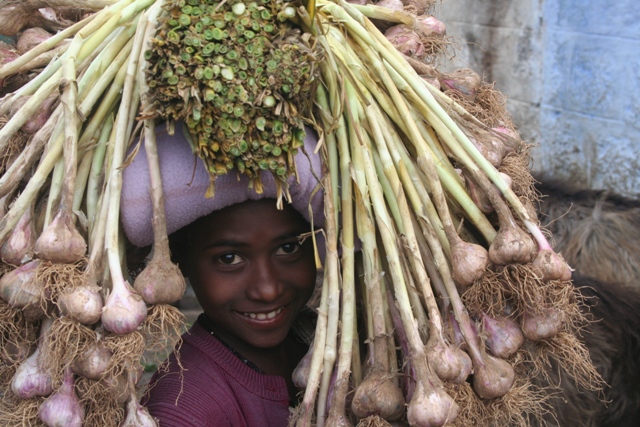 crazy
when they saw us and their rowdy
cheering and shouts were positively frightening. Many stopped us
to ask the time or get directions to the next viewpoint and then left
in fits of giggles, obviously thrilled at having screwed up the courage
to speak to a flesh and blood foreigner. This was not the tranquil
Kodai we recalled from our last visit nearly ten years ago. We
would have been on our way almost immediately had we not met a couple
of travelers who told us about a small village called Vattakanal just
4 kilometers away that had become something of a laid-back hangout for
foreign tourists. A small brick cottage with a wood-burning stove
in the corner and fantastic views of the surrounding forest and
mountains became home for the next to weeks. We were up every
morning before 6:00 to catch the spectacular sunrises and enjoy the
warmth of the early rays before the mist rolled in. The days were
spent drinking steaming cups of masala tea, going for long walks in the
hills and catching up on some reading. After all that rest it
was hard to tear
ourselves away, but we finally hit the road again . After
suffering on the sweltering plains of South India for a few days,
we're ready to cool off. Tomorrow morning a big climb awaits us,
back up over 2,000 meters to the mother of all hill stations, Ooty.
Then we'll swoop back down to the plains for more yoga in Mysore
before returning to Auroville and then Chennai for our flight back to
South Africa in mid-July.
crazy
when they saw us and their rowdy
cheering and shouts were positively frightening. Many stopped us
to ask the time or get directions to the next viewpoint and then left
in fits of giggles, obviously thrilled at having screwed up the courage
to speak to a flesh and blood foreigner. This was not the tranquil
Kodai we recalled from our last visit nearly ten years ago. We
would have been on our way almost immediately had we not met a couple
of travelers who told us about a small village called Vattakanal just
4 kilometers away that had become something of a laid-back hangout for
foreign tourists. A small brick cottage with a wood-burning stove
in the corner and fantastic views of the surrounding forest and
mountains became home for the next to weeks. We were up every
morning before 6:00 to catch the spectacular sunrises and enjoy the
warmth of the early rays before the mist rolled in. The days were
spent drinking steaming cups of masala tea, going for long walks in the
hills and catching up on some reading. After all that rest it
was hard to tear
ourselves away, but we finally hit the road again . After
suffering on the sweltering plains of South India for a few days,
we're ready to cool off. Tomorrow morning a big climb awaits us,
back up over 2,000 meters to the mother of all hill stations, Ooty.
Then we'll swoop back down to the plains for more yoga in Mysore
before returning to Auroville and then Chennai for our flight back to
South Africa in mid-July. 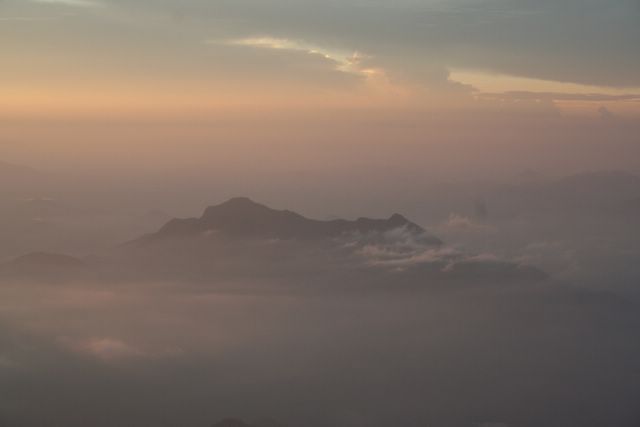
contact us at: worldbiking@gmail.com
Support our chosen charity and help educate girls in Africa-more info here
